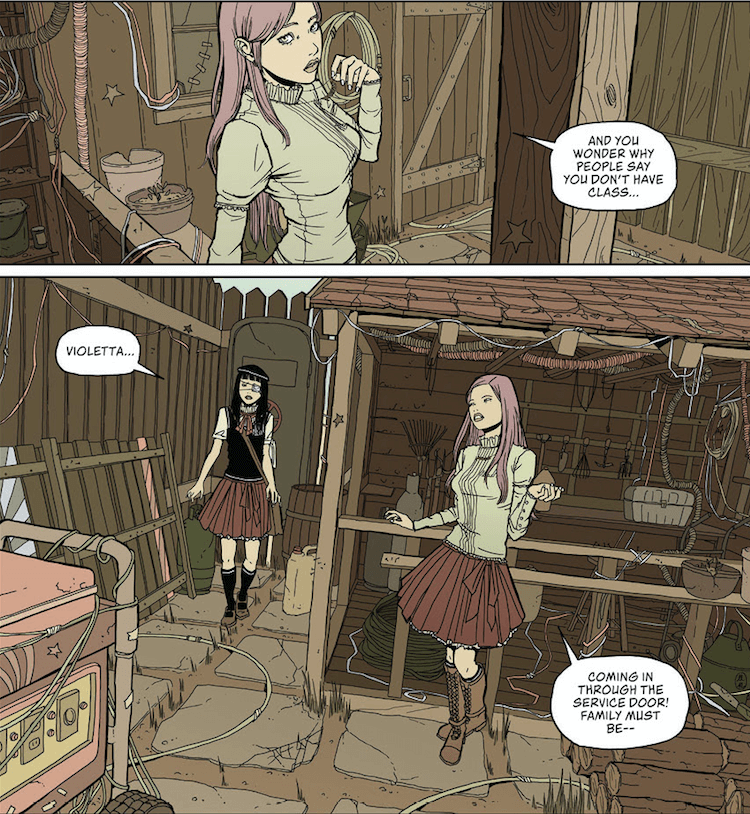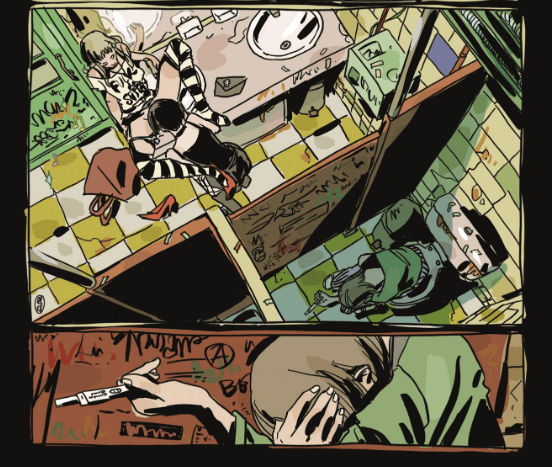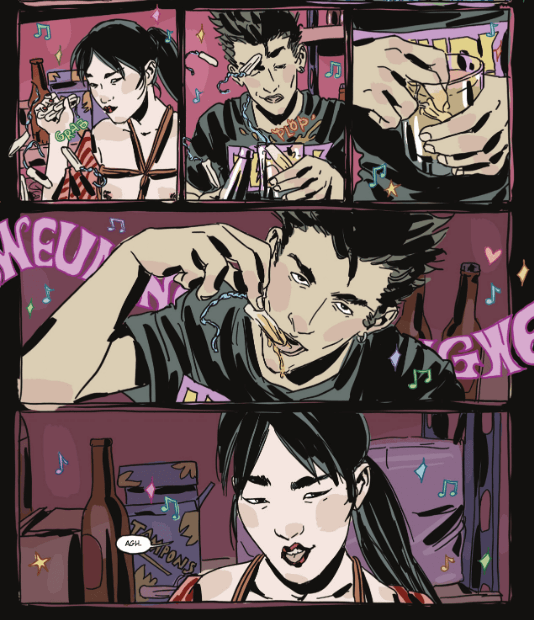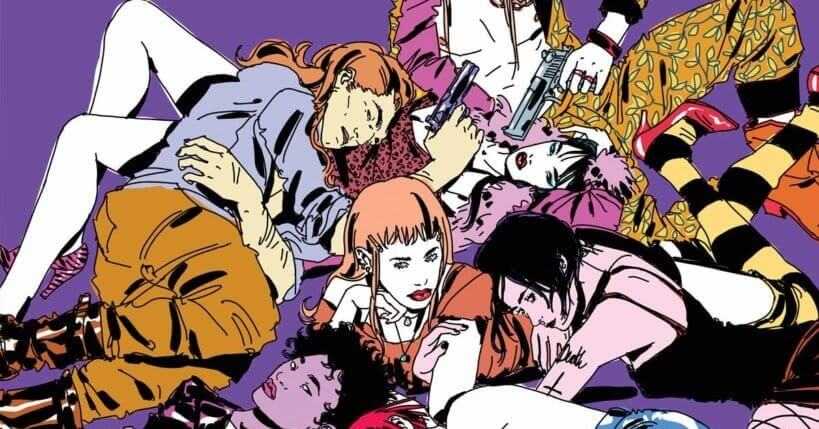Though active in the Spanish and French scenes for much longer, Maria Llovet has been establishing her name in English-language, American-published comics for the last three years. From a miniseries at Black Mask to a collab with Brian Azarrello at BOOM!, her standing is solid as a line and colour artist on men’s scripts. But it’s also solid as a solo cartoonist, as seen in Heartbeat and, most dazzlingly of all, LOUD. LOUD is out as a collected edition from Black Mask in May.
LOUD
Maria Llovet (writer and artist)
Black Mask
May 2020
Around 2005 I saw a picture of the cover of a Yamada Naito book, about an inch and a quarter high in a French magazine. I don’t read French well enough to have been able to learn much; there wasn’t a lot of detail offered, anyway. But the drawing of Yamada Naito was enough to recruit me. I looked at that tiny image and I saw my favourite artist. Not my “new” favourite artist—an artist whose practice embodied everything I had been waiting to see. Sulky, louche, clothes that have been sweated in and hair that’s full of texture, all implied with minimal but purposefully unsmooth lines, Yamada’s works are studies in the aggressive possibility of the consciously naive. They’re challenging without appearing to challenge anything directly; they challenge the right of an onlooker to look on, even as commercial art. Rather they say “Look, but that’s it. Your response isn’t something we require.”
Her stories are often sexual and violent—and always quiet. Her covers combine line drawings scrubbily painted with photographs of real, crapurban environments and her atmosphere is anticapitalist through the vague implication of how economic stratification affects the spirit, which then affects the behaviour necessary for the individual or the socially close to experience distracting or momentarily gratifying stimulation. In LOUD Maria Llovet is a Yamada Naito on gutter Skittles, all that same wonderful insouciant confidence in a grubby rainbow full of laser beam lights and colour-held sound effects. Every person has the bumping, tipsy fecundity of a bee struggling on a flower laden with pollen.
Llovet has been great for a good while. In the English-language market, There’s Nothing There (Black Mask, 2017) was full of clotted black, bourgeois gothica and sexual interaction that look almost auto-drawn. It’s exciting work, dreamlike without being either light or cruel. A floating, twisting, horrorotic visual narrative that lets a story about the fear of guilt feel natural and explorative instead of threatening. Her solo work, Heartbeat, currently republishing in English at BOOM!, is much older, originally drawn in 2012 according to one interview and much neater—more diplomatic, more apologetic (below). The body language is as free and dolly-theatrical, but all the lines look “finished” and the beauty is anxious—imperfection looks like a source of fear where later work embraces it as fuel for the imaginative assumption, a source of power. Looking at this book side to side with Llovet’s current work it’s not even obvious they’re the same artist. Looking at Heartbeat as a seven-year precursor to LOUD, or her collaboration with Azzarello, Faithless, it’s immensely gratifying to watch the development of a liberated Great.

I feel I haven’t talked enough of how much an influence Ai Yazawa’s work was for me as an artist.
I feel connected to it in so many levels, she was different from what I was used of reading; different in style and different in the way she approached + pic.twitter.com/rPgN3fmJLC— maria llovet (@m_llovet) March 8, 2020
On Twitter, Llovet discussed Ai Yazawa as a formative influence (above; March 2020). This is pretty visible in her work, which is satisfying to discover, and it’s enjoyable to see respect from one power to another. Yazawa and Yamada both began their careers in the mid-eighties and their output has some similarities: the heaviness of their big eyes, the regularity of their line width, and the studied audacity (a sort of claimed but deniable blamelessness—what, this? Who, me? Am I doing something? Could you prove it?) in the design and character of their feminine elements. The subversive potential of embracing truths about oneself that are otherwise coded as weak. Yamada’s series all or often featured emergent sexuality, queer understandings, complicated, even miserable romantic interactions and the deep personal catharsis that garments can provide.

LOUD is less of a narrative than Nana or Paradise Kiss, less involved with dialogue exchange or inner monologue or character growth—more of a trip through a series of overheard evenings as an equally anonymous club attendee than the voyeuristic access to the inner thoughts and dreams of a spread cast that a “story” usually is. But it hits those same free beats, maxed up for a less-defined market. Yazawa was usually writing for girls’ magazines; Llovet is for hipsters I guess. More death, more bullets, more of the physical betrayals put on the page (there’s a rape and a threatened rape, amongst all the consensual frottage and negotiated sex). Ugly and beautiful mean just about the same thing; desire is a constant rather than a joy, and morality in the judgemental sense survives only in catchphrase-able, ultimate moments like “Death to paedophiles” and “It’s OK to kill a killer.” The characters and their overtures are sexy and annoying, and no lover’s obliged to supply any compassion or assurance outside of what drives their own interest.

The tone of the story isn’t really dark, but it’s not uplifting either. It’s midtoned, like the palette, a sort of party nihilism that’s comparable to a lower age-rated action movie’s sense of what “matters.” Like Tango, LOUD allows its subjects’ sadnesses, violations, desperations and deaths to be only as emotionally impactful as they need to be to keep the wagon rolling, and only as sleazy as is still happy-go-lucky to watch. Nobody on the page really sympathizes with anybody else—they’re just all self-involved, not especially mean—and that clues the reader in to how equally they should skim over imagining the consequences of what they’re seeing, or what it means, and only concentrate on what’s tickling their tits right now. Not a lot of people are publishing effective hedonism comics for the English-language market right now. Llovet’s vision of “who fucks” is well ranged, though a major criticism is there are no fat characters in this horny galleria.
Much as I appreciate seeing a cartoonist play so well with riptides and undertows in a concept-based action piece like this, I would love to see Llovet working with more experimental writers—I’d love to see her skill with the liminal and the stimulated tuned around some beautiful dialogue and cleverly structured intrigue in a longer format. But I’d also be happy with watching this career take any solo turn it fancied. Whatever she does next, it will be worth buying in.





